 |
When told that the horse is a
Canadian, the first question we always get asked is...
"Yes, but what breed is it?"
Fortunately, in the last few years, the breed is generating
interest and people are becoming aware of its existence.
We think the breed is one of Canada's best kept secrets!
History and Origin
of the Breed
For generations the Canadian
Horse played a vital role in the lives of the
early settlers, not only in Canada, but in the
United States as well. Today, however, few North
Americans are aware of its existence and very
little information can be found on this once extremely
popular breed. Listed as "critical" by the American
Livestock Breeds Conservancy the Canadian Horse
numbers approximately 2500 head, the majority
of these being in eastern Canada. Recently there
has been a resurgence in the breed's popularity
and more horse enthusiasts are becoming aware
of the special qualities of "the little iron horse"
as it was affectionately nicknamed by the early
inhabitants.
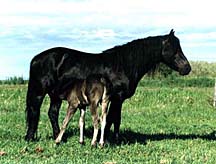 The Canadian Horse traces its ancestry to
the foundation stock brought to Acadia and New
France in the 17th century. The first horses were
ultimately caught and carried off in 1616 by Samuel
Argall's marauding expedition from Virginia. The Canadian Horse traces its ancestry to
the foundation stock brought to Acadia and New
France in the 17th century. The first horses were
ultimately caught and carried off in 1616 by Samuel
Argall's marauding expedition from Virginia.
This was the first introduction of French Canadian
blood to America's eastern shores. The effective
introduction of French horses in to New France
came in 1665 when Louis XIV sent two stallions
and twenty mares from the royal stables to the
colony. On the voyage eight of the mares were
lost, but the King sent additional shipments;
in 1667 fourteen or fifteen horses, and in 1670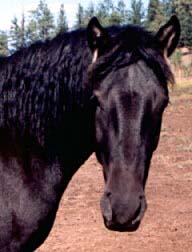 a stallion and eleven mares. These horses
formed the basis of the French a stallion and eleven mares. These horses
formed the basis of the French
Canadian horse of the Old Regime.
The horses from the Royal stables came from Normandy
and Brittany, at that time the two most renowned
horse breeding provinces of France. The Breton
horse, although small, was noted for its soundness
and vigor. The Norman horse closely resembled
the Breton, but gave more evidence of infusion
of oriental blood. This strain came from Andalusian
sires brought in to Normandy and La Perch (habitat
of the Percheron breed) for breeding purposes,
some direct from Spain and others, between the
latter part of the 16th century and the end of
the War of Spanish Succession, from the Spanish
Netherlands. Influence of the Dutch Friesian is
apparent in the notable trotting ability of the
Canadian, the feathered legs, abundance of mane
and tail, and general appearance.
In the 17th and 18th centuries there was no standard
type in either the Norman or Breton breeds but
rather several types in each, being bred with
one another in their home province according to
the features popular at the moment. Among the
horses brought from France in to Canada there
were various types; some were distinctively draft
in type; others were just as distinctively trotters,
a type of horse for which France had enjoyed a
reputation for generations.
Still others were pacers, not descending from
the Narragansett Pacers as is often implied, but
coming from France with that talent. A gross error
is made by those who attribute all of the credit
for the American trotters to the horses of England.
Although the Canadian horse exhibited several
types due to varied breeding practices of the
time, there was no other blood infused in to the
breed for nearly 150 years. Many owners bred for
the lighter, more refined type, and it is said
that the pure breed as it existed in 1850 was
scarcely altered from its prototype of a hundred
years before.
Canadian Horses cleared and worked the land, carried
children to school, pulled the cutters and carriages
and provided great entertainment for their masters
in the form of racing. They endured many hardships
- from brutally cold winters to hoards of mosquitoes
and flies during the summer, poor feed and long
hours of work with little rest. They survived
it all, but became smaller in size - thus the
title: Little Iron Horse. They gained quite a
reputation for their hardiness and stamina and
many stories were told of their courage and ability.
One such story was told in the Breeders Gazette
of Chicago in 1914: A wood merchant, owner of
a Canadian Horse weighing approximately 1050 pounds
harnessed it on the same pole beside another horse,
two hundred pounds heavier. to school, pulled the cutters and carriages
and provided great entertainment for their masters
in the form of racing. They endured many hardships
- from brutally cold winters to hoards of mosquitoes
and flies during the summer, poor feed and long
hours of work with little rest. They survived
it all, but became smaller in size - thus the
title: Little Iron Horse. They gained quite a
reputation for their hardiness and stamina and
many stories were told of their courage and ability.
One such story was told in the Breeders Gazette
of Chicago in 1914: A wood merchant, owner of
a Canadian Horse weighing approximately 1050 pounds
harnessed it on the same pole beside another horse,
two hundred pounds heavier.
The Canadian Horse has always kept his harness
traces well stretched and never showed as much
fatigue as his heavier mate. After two years of
common work, the heavy horse died. Questioned
on the cause of death, the driver answered, "It
is the Canadian Horse that made him die of overwork"!
Another heavy horse teamed with the same Canadian
Horse died after a year and the Canadian was still
in perfect condition. Little wonder that with
such a reputation the British settlers would start
to demand the Canadian for use in crossbreeding
with their own horses. Canadians had the quality
of breeding up in size as well as giving the foals
their pluck, vigor and iron constitution.
They were described as being long-lived, easily
kept, and capable of great endurance - heavy enough
for the purposes of the farmer or as a roadster
while also being a good riding horse. The breed
produced both trotters and pacers. Thus Canadian
Horses found a ready market in the United States
and were also shipped in great quantities to the
West Indies. Very little care was given to the
early Canadian breed, and it is a testimony to
their hardiness that they survived. In summer,
when the horses were little used, they ran loose
in the woods, where they were tormented by flies
against which they had no defense due to the French practice of docking the
tails. In the winter they were usually given no
shelter at all, especially the young stock which
were not in use. The inhabitants cured no hay
so their horses existed mostly on straw. They
seldom received enough grain but were required
to work hard. due to the French practice of docking the
tails. In the winter they were usually given no
shelter at all, especially the young stock which
were not in use. The inhabitants cured no hay
so their horses existed mostly on straw. They
seldom received enough grain but were required
to work hard.
When the owners took to the road they thought
nothing of driving the horses as fast as they
would go for a dozen miles or more, then leaving
them to stand uncovered for hours in blizzard
conditions. It was their opinion that harsh exposure
was an excellent way to toughen an animal. New
France furnished the horses taken to the western
settlements at Detroit and in the Illinois area.
Many of these horses were allowed to run loose
in large herds and were only brought in when needed
for work.
Great numbers are known to have escaped to run
with the mustangs of the American plains - an
ancestor never mentioned in writings of the American
Mustang. After the war of 1812, the trade in French
Canadian horses grew rapidly. American dealers
collected droves each year, mostly at Montreal
and Quebec City. In 1830 it was reported that
most of the trotters then in the northern United
States were of French Canadian origin. Beneficial
result of crossing the Canadian on the ordinary
stock of the adjacent states was universally admitted.
The popularity of the crossbred horses of northern
New England among the stagecoach drivers of Boston
is legend. The stallions brought from Lower Canada
were not entirely responsible, however, for the
infusion of Canadian blood in to the horses of
the United States. Part of it came from both purebred
and part bred Canadian mares, which were mated
to American horses.
The Canadian Pacer was a horse bred from the Narragansett
Pacer and the old strains of French-Canadian.
This breed then returned to the United States
and contributed greatly to development of the
famous American Standardbred. Many purebred French
Canadian horses were entered in to the early studbooks
of the Morgan, Standardbred, and American Saddlebred.
Foundation sires of these breeds were often pure
Canadian or were mated to Canadian mares. The
Tennessee Walking Horse and Missouri Foxtrotter
can also claim Canadian ancestry.
So great was the drain in to the United States
of the pure Canadian horse, particularly during
the Civil War, that numbers at home were reduced
alarmingly. Another factor involved in the demise
of the breed was the importation of heavy draft
horses for farm work. The Canadian was never considered
a work horse although it was worked hard, and
it also never qualified as a light breed, being
a more medium type (a description also given of
the Morgan). By the end of the nineteenth century
the breed was in extreme danger of extinction.
Under the leadership of Dr. J. A. Couture, DVM,
a few concerned admirers of the "little iron horse"
banded together to try and preserve what remained
of the breed.Their efforts produced a first stud
book in 1886.
Progress was slow however, and it was not until
1895 when the Canadian Horse Breeders Association
was formed that any real expansion took place.
In 1907 under the leadership of Dr. J.G. Rutherford,
the federal government livestock commissioner,
a new studbook was started with improved standards.
In 1913 the Federal Ministry of Agriculture set
up a breeding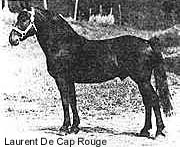 program at Cap Rouge, Quebec, where Albert
de Cap Rouge, one of the foundation studs was
bred. The operation was later moved east of Quebec
City at St. Joachim. program at Cap Rouge, Quebec, where Albert
de Cap Rouge, one of the foundation studs was
bred. The operation was later moved east of Quebec
City at St. Joachim.
During this period the Canadian was bred into
a taller more refined animal, suitable as a hunter
or jumper. When the federal government, occupied
with the war, closed down the operation in 1940
and sold off the breeding stock, the Quebec government
reestablished the stud under the provincial department
of agriculture at Deschambault, Quebec. The balance
of the St. Joachim horses were sold to private
breeders. In 1979 the Deschambault herd was sold
at auction and the Canadian was once again threatened
with extinction numbering less than 400 registered
horses. However, thanks to the efforts of committed
breeders all across Canada, the breed struggles
on and at present (1997) numbers approximately
2500 registered horses.
Breed characteristics the Canadian Horse can be
called a general utility animal. The mares are
extraordinarily 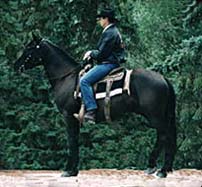 fertile and reproduce regularly until the
age of 20 or older. Generally the Canadian Horse
is black, but colors also range from bay to light
chestnut. Stallions should weigh from 1050 to
1350 pounds and mares 1000 to 1250. Desired height
is 14 to 16 hands. As a general purpose animal,
the Canadian shows a well-proportioned body, good
setting of limbs, high quality of bones, and good
feet. The forearm and gaskin are especially fertile and reproduce regularly until the
age of 20 or older. Generally the Canadian Horse
is black, but colors also range from bay to light
chestnut. Stallions should weigh from 1050 to
1350 pounds and mares 1000 to 1250. Desired height
is 14 to 16 hands. As a general purpose animal,
the Canadian shows a well-proportioned body, good
setting of limbs, high quality of bones, and good
feet. The forearm and gaskin are especially 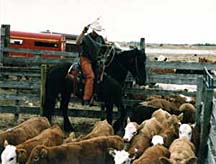 well muscled. The mane and tail are thick,
long and usually wavy. The head shows intelligence,
spirit, and no excess of nervousness. The animal
is generally very easy to handle. The Canadian's
strength and docility make it ideal for farm work,
ranch work, driving, hunter/jumping, packing and
endurance riding. True to its heritage the Canadian
demonstrates its versatility by performing superbly
in all equestrian disciplines. Willingness, adaptability,
and an even temperament make the Canadian ideal
for use in competition, for working, or as a family
horse. well muscled. The mane and tail are thick,
long and usually wavy. The head shows intelligence,
spirit, and no excess of nervousness. The animal
is generally very easy to handle. The Canadian's
strength and docility make it ideal for farm work,
ranch work, driving, hunter/jumping, packing and
endurance riding. True to its heritage the Canadian
demonstrates its versatility by performing superbly
in all equestrian disciplines. Willingness, adaptability,
and an even temperament make the Canadian ideal
for use in competition, for working, or as a family
horse.
|
|
|
|
|
|
Knightland Farms
Kevin and Gloria McKnight
Box 1773
Gimli, MB
R0C 1B0
Email: kmcknight@inethome.ca
Phone : (204) 642-8151 or Cell (204) 641-1211
|
|